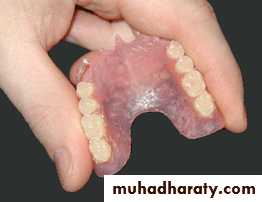POLYMERIZATION (CURING ) It is a chemical process which involves the generation of relatively long molecules (polymer) from small component units ( monomer), or;; the process consists of the monomer units becoming chemically linked together to form high molecular weight molecules.Polymerization stages: Polymerization of acrylics usually occurs in 4 chemical stages summarized as follows:
1.ACTIVATION STAGE : the chemical reaction is activated by one of the following techniques:a. thermal activation by heating over than 65ºC by either a water bath or microwave oven. b. chemical activation: the reaction is activated by a chemical agent (accelerator) which is incorporated in the liquid.c. visible-light activation: by light of a specific wave length.
2.INITIATION STAGE: the reaction is initiated, i.e. the curing starts.3.PROPAGATION STAGE: the reaction continues and growing long molecules or chains of polymer are produced.4.TERMINATION STAGE: the molecules reaction is terminated, but the polymerization is ever never be stopped as monomer residue is still present in the final set acrylic material.
Activation Techniques of Acrylic Resin:1. heat-curing technique; either by a water bath over 65C or by microwave energy. The acrylic resin materials are supplied as powder and liquid.2. chemical-/ cold-/ auto-/ self-curing technique; The acrylic resin materials are supplied as powder and liquid and auto polymerized.3. light-curing technique; The acrylic resin materials are supplied as a single component and cured by high-intensity visible light source.
MANIPULATION OF CHEMICAL-CURED RESINS: A powder-liquid ratio of 3:1 is used or according to manufacturer instructions. The powder and liquid are mixed in a glass jar and covered. The mixture passes through the following physical changes:1. sand stage: the mixed material.2.stick stage: the material is sticking to the spatula and fingers and sides of mixing vessel, so, it is unworkable.3.dough stage: the mixture is more cohesive and less stickiness and can be separated easily from the side of the mixing jar. The material now is moldable and workable and can be shaped according to use.4.rubber stage: the material is rubber-like and unworkable.5.hard solid stage.
Doughing time: the time taken to reach the dough stage.Working time of acrylic: the time in which the material remains at the dough stage and it is moldable and workable.
MANIPULATION OF HEAT-CURED RESINS: The procedure is same as that of chemical-cured resin, but when the mixture reaches the dough stage, the material is packed into a flask and then cured in a water bath using one of these cycles: Water bath curing cycles;1. long cycle: is to heat the water of the bath containing the flask for 7 hours at 70 0C followed by 3 hours at 100 0C.2. short cycle: tap water is placed in the bath containing the flask. The water is gradually brought to the boil over a period of 1 hour. Then the water is allowed to boil for 1 hour. Then the flask is cooled slowly on bench, and deflasked. The hard acrylic denture cleaned, finished and polished.
Polymerization of heat cured acrylic resins by microwave energy:This process required :1.a specially formulated resin.2.non metallic flask3.a conventional microwave oven to supply the thermal energy.
Advantages of microwave acrylic resins :1.speed of polymerization 2.the physical properties of microwave resins are comparable to conventional resins3.the fit of microwave denture bases are comparable with conventional ones.
Light activated denture base resins: Chemical composition: this material has been described as a composite having the following composition:1.urethane dimethacrylate 2.microfine silica3.high-molecular weight acrylic resin monomer4.organic filler (acrylic resin beads)5.initiator (camphoroquinone)
Polymerization of Light activated denture base resins This type of denture base is supplied as a single component in sheet and rope forms and is packed in light-proof pouches to prevent inadvertent polymerization. The light activated denture resins cannot be flasked in a conventional manner because opaque investing media prevents the passage of light. Instead teeth are arranged and the light-activated resin is molded on an accurate cast. Then it is exposed to a high-intensity visible light source for an appropriate period. After polymerization the denture is finished and polished in a conventional manner.
Flexible denture base materials Thermoplastic materials for dental prostheses, Valplast and Flexiplast, were first introduced to dentistry in the 1950. Both materials were similar grades of Polyamides (nylon plastics). Since their introduction, there has been a continued interest in thermoplastic dental materials.
Flexible denture base materials
Thermoplastic resins have and are being used for a broad variety of applications from removable flexible partial dentures, preformed partialdenture clasps, fiber reinforced fixed partial dentures, temporary crowns and bridges, provisional crowns and bridges, obturators and speech therapy appliances, orthodontic retainers and brackets, impression tray and border molding materials, occlusal splints, sleep apnea appliances, and implant abutments.
Advantages of thermoplastic materials
Thermoplastic resins and co-polymers have many advantages over conventional powder or liquid resin systems. Thermoplastic resins tend to have predictable long-term performance.1.They are stable and resist thermal polymer unzipping.
2.They exhibit high creep resistance
3. They have high fatigue endurance
4. They have excellent wear and solvent resistance.
5. They typically have very little or almost no free monomer in the material.
6. They have almost no porosity, which reduces biologic material build up, odors, and stains.
7. They exhibit higher dimension and color stability.
8.Typically they are more flexible and stronger than their traditional counterparts.
9. They can also be reinforced with glass filler or fibers to further enhance their physical properties.
10. They can be relined and repaired, by repressing the restoration.
11. They can produce single cast or pressed restorations that are strong, lightweight, flexible appliances in tissue or tooth color matched materials that never need adjusting.12. They display excellent esthetics and provide long-term comfortable use for the patient. This provides excellent alternative cosmetic restorations for esthetic conscious patients.



